Page 208 of 407
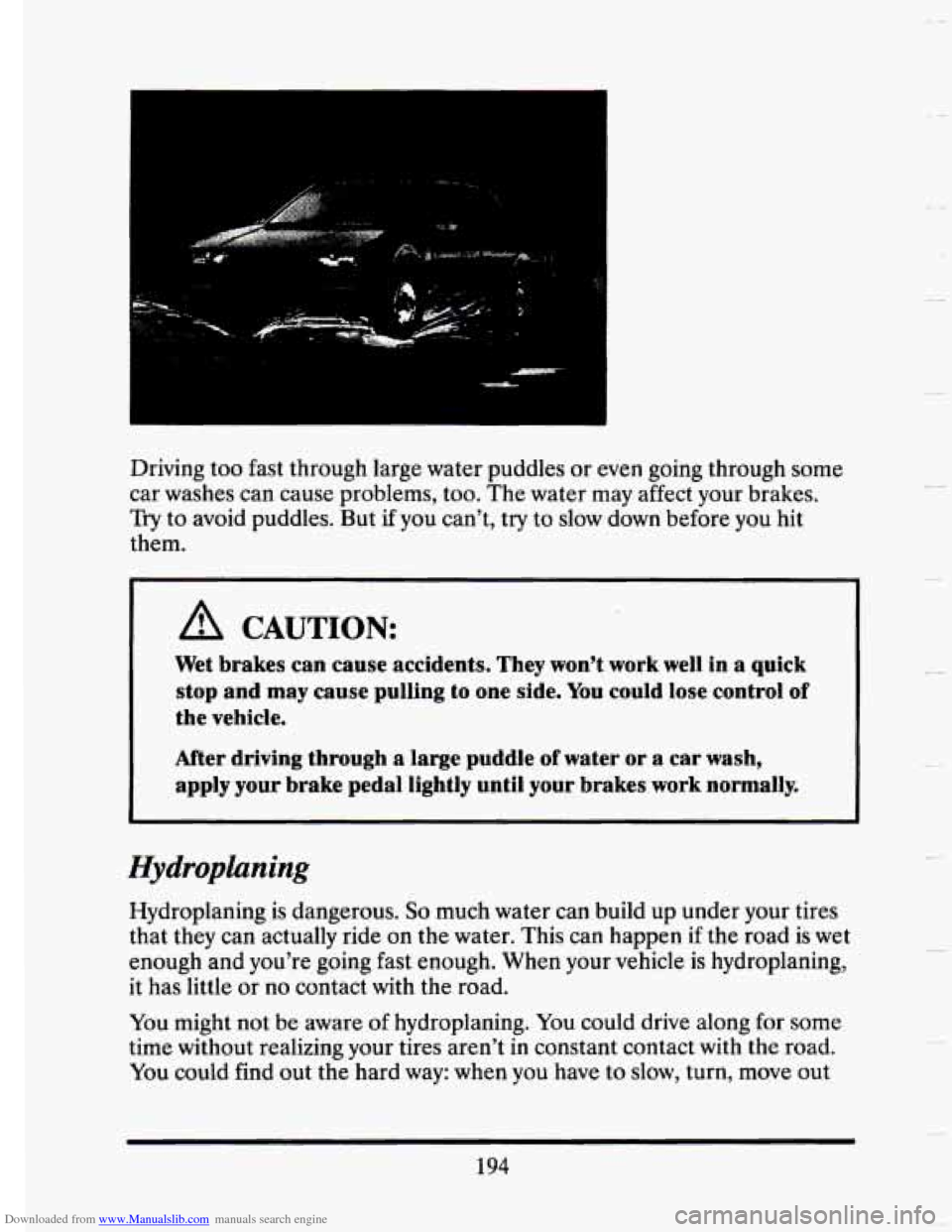
Downloaded from www.Manualslib.com manuals search engine Driving too fast throl
car washes can cause
Try to avoid puddles.
them. Igh
large water puddles
or even going through some
problems, too. The water may affect your brakes.
But
if you can’t, try to slow down before you hit
r
A CAUTION:
Wet brakes can cause accidents. They won’t work well in a quick\
stop and may cause pulling to one side. You could lose control
of
the vehicle.
After driving through a large puddle
of water or a car wash,
apply your brake pedal lightly until your brakes work normally.
Hydroplaning
Hydroplaning is dangerous. So much water can build up under your tires
that they can actually ride on the water. This can happen
if the road is wet
enough and you’re going fast enough. When your vehicle
is hydroplaning,
it has little or no contact with the road.
You might not be aware
of hydroplaning. You could drive along for some
time without realizing your tires aren’t in constant contact with the road.
You could find out the hard way: when you have to slow, turn, move out
194
Page 209 of 407
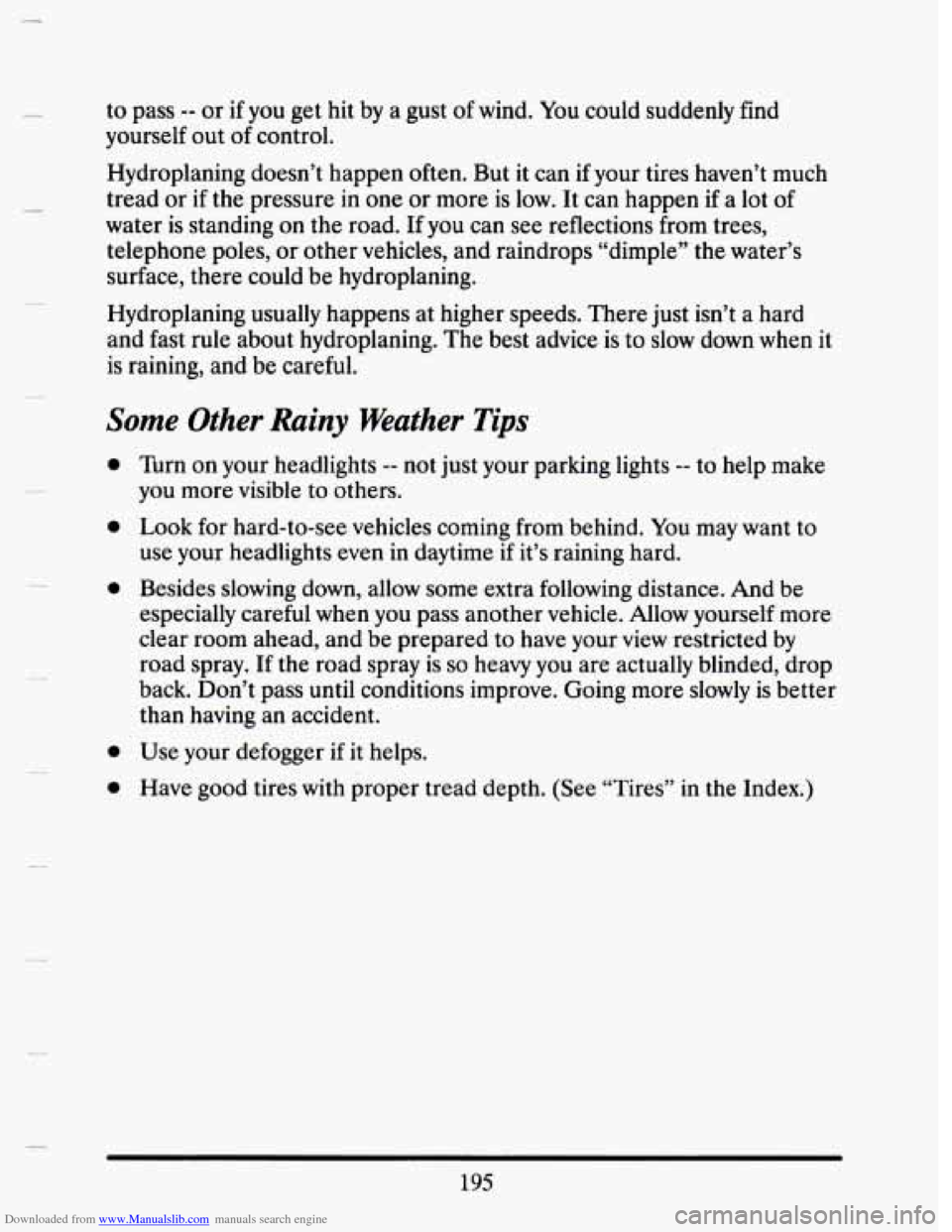
Downloaded from www.Manualslib.com manuals search engine to pass -- or if you get hit by a gust of wind. You could suddenly find
yourself out of control.
Hydroplaning doesn’t happen often. But it can
if your tires haven’t much
tread or
if the pressure in one or more is low. It can happen if a lot of
water is standing
on the road. If you can see reflections from trees,
telephone poles, or other vehicles, and raindrops “dimple” the water’s
surface, there could be hydroplaning.
Hydroplaning usually happens at higher speeds. There just isn’t a hard
and fast rule about hydroplaning. The best advice is to slow down when it
is raining, and be careful.
Some Other Rainy Weather Tips
a
a
a
a
a
Turn on your headlights -- not just your parking lights -- to help make
you more visible to others.
Look for hard-to-see vehicles coming from behind. You may want to
use your headlights even
in daytime if it’s raining hard.
Besides slowing down, allow some extra following distance. And \
be
especially careful when you pass another vehicle. Allow yourself more
clear room ahead, and be prepared
to have your view restricted by
road spray. If the road spray is so heavy you are actually blinded, drop
back. Don’t pass until conditions improve. Going more slowly \
is better
than having an accident.
Use your defogger
if it helps.
Have good tires
with proper tread depth. (See “Tires” in the Index.)
195
Page 216 of 407
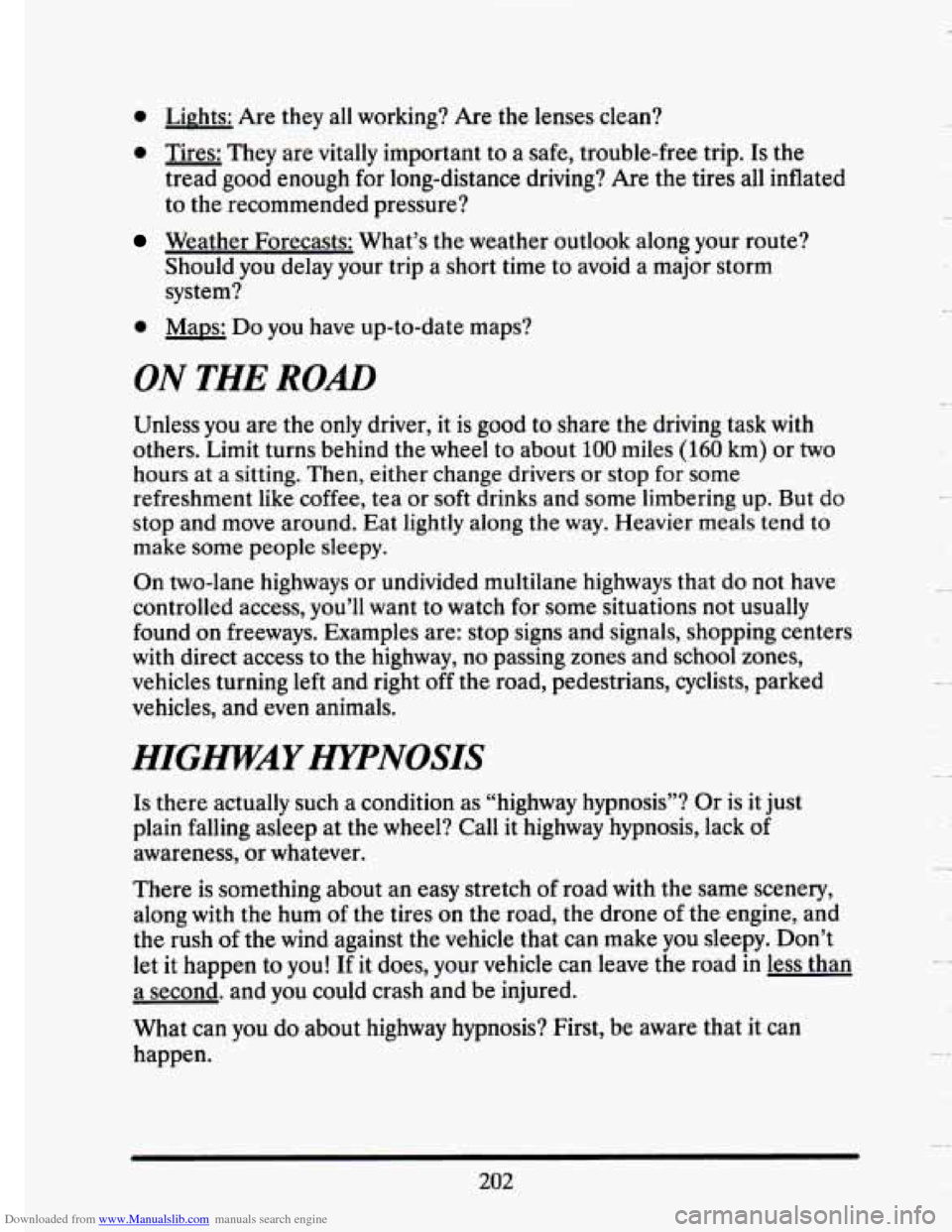
Downloaded from www.Manualslib.com manuals search engine 0 Lights: Are they all working? Are the lenses clean?
0 Tires: They are vitally important to a safe, trouble-free trip. Is the
tread good enough for long-distance driving? Are the tires all inflated
to the recommended pressure?
Weather Forecasts: What’s the weather outlook along your route?
Should you delay your trip a short time to avoid a major storm
system?
0 Maps: Do you have up-to-date maps?
ON THE ROAD
Unless you are the only driver, it is good to share the driving task with
others. Limit turns behind the wheel
to about 100 miles (160 km) or two
hours at
a sitting. Then, either change drivers or stop for some
refreshment like coffee, tea or soft drinks and some limbering up. But
do
stop and move around. Eat lightly along the way. Heavier meals tend to
make some people sleepy.
On two-lane highways or
undivided multilane highways that do not have
controlled access, you’ll want to watch for some situations not usually
found
on freeways. Examples are: stop signs and signals, shopping centers
with direct access
to the highway, no passing zones and school zones,
vehicles turning left and right off the road, pedestrians, cyclists, parked
vehicles, and
even animals.
I
HIGWAY HypNosIS
Is there actually such a condition as “highway hypnosis”? Or is it just
plain falling asleep at the wheel? Call it highway hypnosis, lack of
awareness, or whatever.
There is something about an easy stretch
of road with the same scenery,
along with the hum
of the tires on the road, the drone of the engine, and
the rush
of the wind against the vehicle that can make you sleepy. Don’t
let it happen
to you! If it does, your vehicle can leave the road in less than
a second. and you could crash and be injured.
What can you do about highway hypnosis? First, be aware that it can
happen.
202
-*
Page 218 of 407
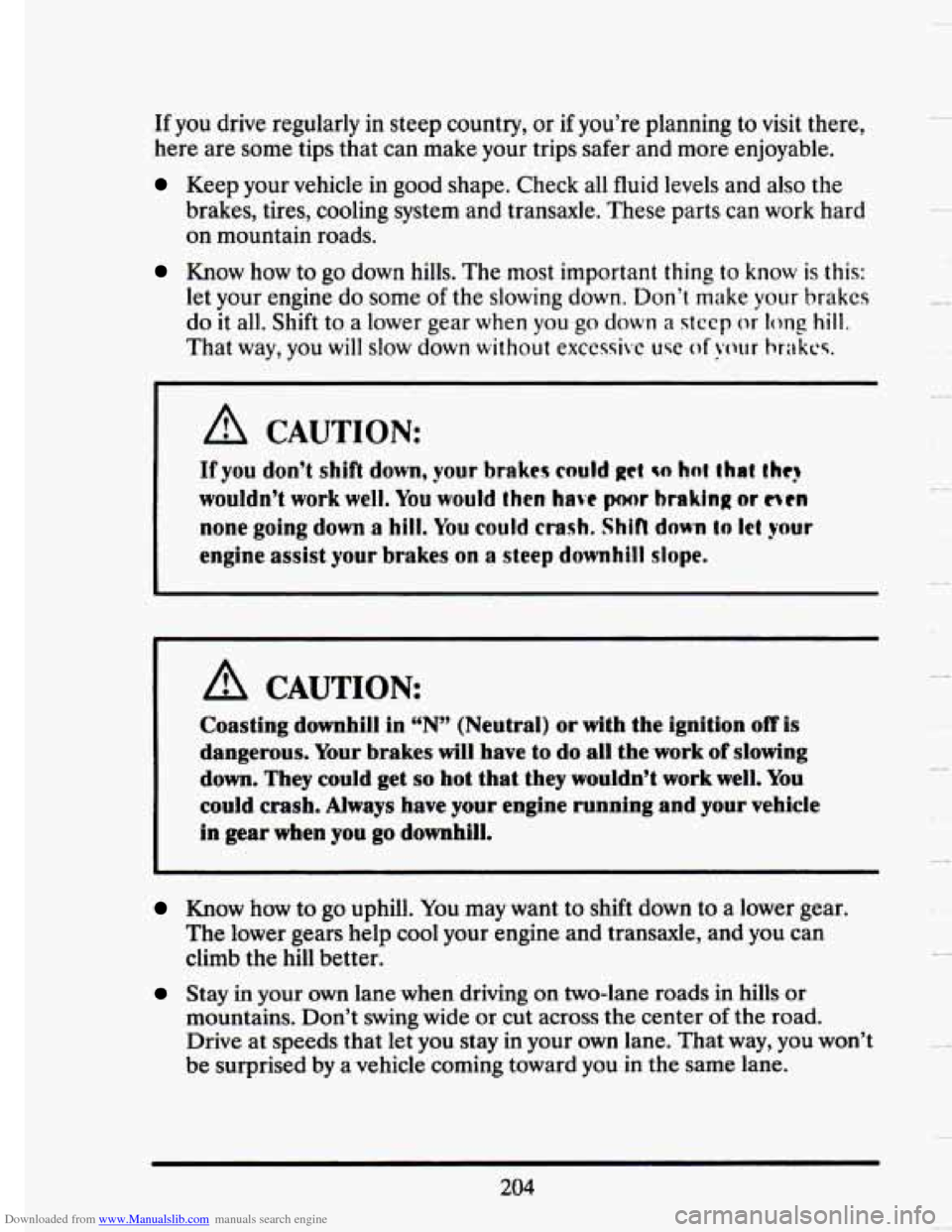
Downloaded from www.Manualslib.com manuals search engine If you drive regularly in steep country, or if you’re planning to visit there,
here are some tips that can make your trips safer and more enjoyable.
Keep your vehicle in good shape. Check all fluid levels and also the
brakes, tires, cooling system and transaxle. These parts can work hard
on mountain roads.
Know how to go down hills. The most important thing to know is this:
let your engine do some of the slowing down. Don’t make your brakes
do it all. Shift to a lower gear when you go down a stcep or long hill.
That way, you will slow down without excessive we of !wr hrilkcs.
I
A CAUTION:
If you don’t shift down, your brakes could get so hot that tht?
wouldn’t work well. You would then have pr braking or men
none going down a hill. You could crash. Shin down to let your
engine assist your brakes on a steep downhill slope.
A CAUTION
Coasting downhill in “N” (Neutral) or with the ignition off is
dangerous. Your brakes will have
to do all the work of slowing
down. They could get
so hot that they wouldn’t work well. You
could crash. Always have your engine running and your vehicle
in
gear when you go downhill.
Know how to go uphill. You may want to shift down to a lower gear.
The lower gears help cool your engine and transaxle, and you can
climb the hill better.
Stay in your own lane when driving on two-lane roads in hills or
mountains. Don’t swing wide or cut across the center
of the road.
Drive at speeds that let you
stay in your own lane. That way, you won’t
be surprised
by a vehicle coming toward you in the same lane.
204
Page 220 of 407
Downloaded from www.Manualslib.com manuals search engine Another part of this manual tells how to use your parking brake (see
"Parking
Brake" in the Index). But on a mountain or steep hill, you can
do one more thing. You can turn your front wheels to keep your vehicle
from rolling downhill or out into traffic.
Here's
how:
Parking Downhill
Parking Uphill
Turn your wheels to
the
right.
You don't have to jam
your tires against the
curb,
if there is a curb.
A gentle contact is all
you need.
If there is
a curb, turn
your wheels to the left
if the curb is
at the
right side
of your
vehicle.
-4
a-
206
Page 222 of 407
Downloaded from www.Manualslib.com manuals search engine If “torque lock” does occur, you may need to have another vehicle pusn
yours a little uphill to take some of the pressure from the transaxle, so
you can pull the shift lever out of “P” (Park).
‘WINTER DmNG
V
Here are some tips for winter driving:
0 Have your Cadillac in good shape for winter. Be sure your engine
coolant
mix is correct.
Snow tires can help in loose snow, but they may give you less traction
on ice than regular tires.
If you do not expect to be driving in deep
snow,
but may have to travel over ice, you may not want to switch to
snow tires at all.
You may want to put winter emergency supplies in your trunk.
208
U
Page 223 of 407
Downloaded from www.Manualslib.com manuals search engine c
Include an ice scraper, a small brush or broom, a supply of windshield
washer fluid, a rag, some winter outer clothing, a small shovel,
a
flashlight, a red cloth, and a couple of reflective warning triangles. And, if
you will be driving under severe conditions, include a small bag of sand, a
piece of old carpet or a couple
of burlap bags to help provide traction. Be
sure you properly secure these items in your vehicle.
Driving on Snow or Ice
Most of the time, those places where your tires meet the road probably\
have
good traction.
However,
if there is snow or ice between your tires and the road, you can
have
a very slippery situation. You’ll have a lot less traction or “grip” and
will need to be very careful.
209
Page 224 of 407
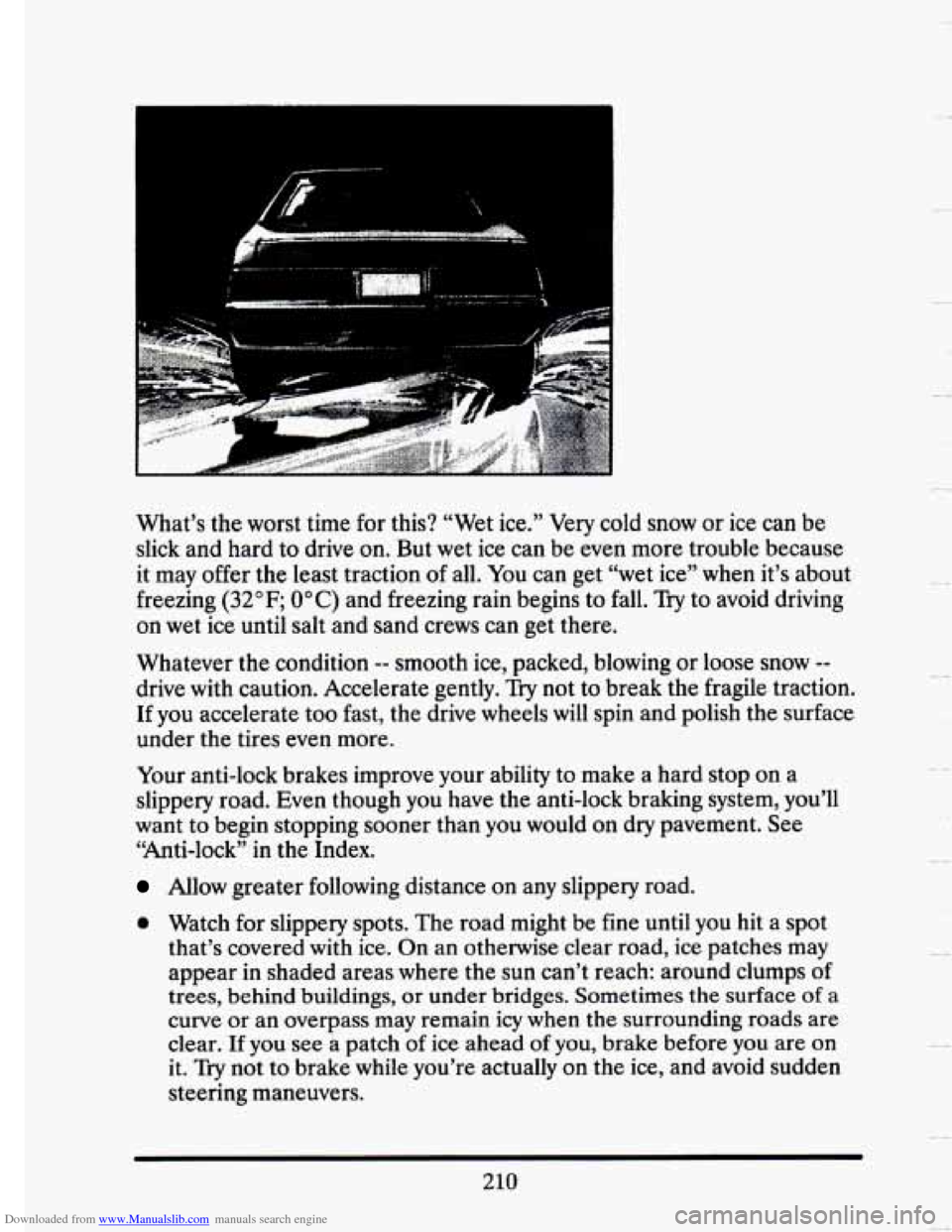
Downloaded from www.Manualslib.com manuals search engine ----
.
What’s the worst time for this? “Wet ice.” Very cold snow or ice can be
slick and hard to drive on. But wet ice can be
even more trouble because
it may offer the least traction
of all. You can get “wet ice” when it’s about
freezing
(32°F; O’C) and freezing rain begins to fall. Try to avoid driving
on wet ice until salt and sand crews can get there.
Whatever the condition
-- smooth ice, packed, blowing or loose snow --
drive with caution. Accelerate gently. Try not to break the fragile traction.
If you accelerate too fast, the drive wheels
will spin and polish the surface
under the tires even more.
Your anti-lock brakes improve your ability to make a hard stop on a
slippery road. Even though you have the anti-lock braking system, you’ll
want to begin stopping sooner than you would on dry pavement. See
“Anti-lock” in the Index.
Allow greater following distance on any slippery road.
0 Watch for slippery spots. The road might be fine until you hit a spot
that’s covered with ice.
On an otherwise clear road, ice patches may
appear
in shaded areas where the sun can’t reach: around clumps of
trees,
behind buildings, or under bridges. Sometimes the surface of a
curve or an overpass may remain icy when the surrounding roads are
clear. If you see a patch of ice ahead of you, brake before
you are on
it. Try not to brake while you’re actually on the ice, and avoid sudden
steering maneuvers.
210
....